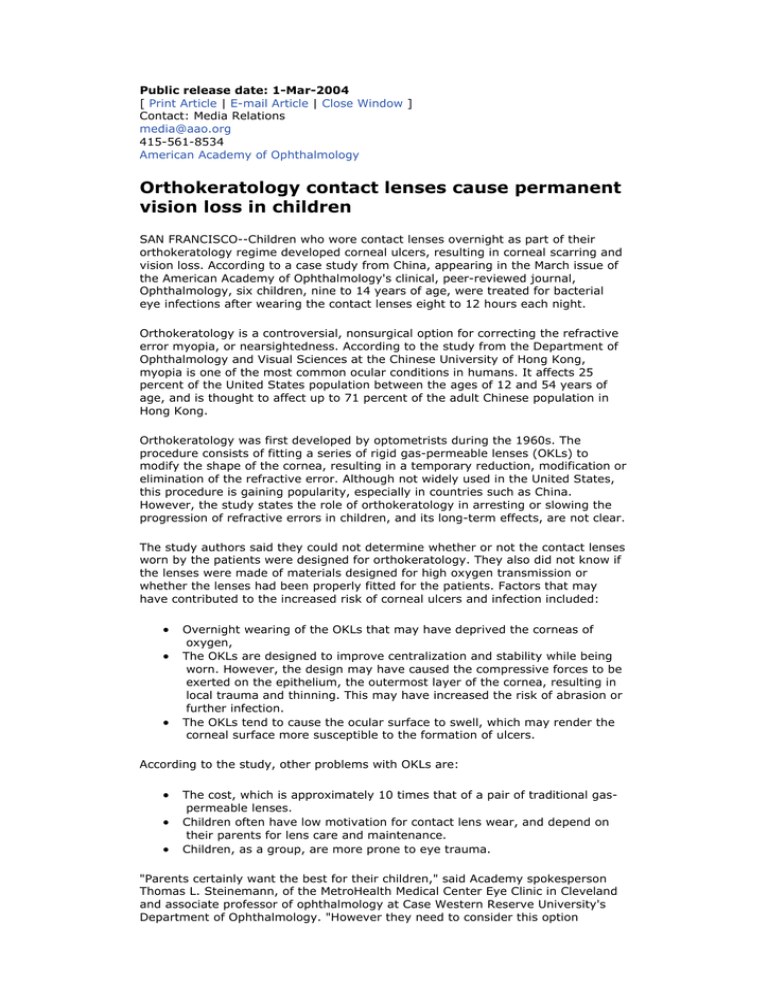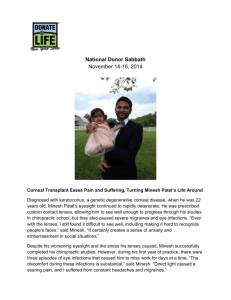Orthokeratology contact lenses cause permanent vision loss in
advertisement

Public release date: 1-Mar-2004 [ Print Article | E-mail Article | Close Window ] Contact: Media Relations media@aao.org 415-561-8534 American Academy of Ophthalmology Orthokeratology contact lenses cause permanent vision loss in children SAN FRANCISCO--Children who wore contact lenses overnight as part of their orthokeratology regime developed corneal ulcers, resulting in corneal scarring and vision loss. According to a case study from China, appearing in the March issue of the American Academy of Ophthalmology's clinical, peer-reviewed journal, Ophthalmology, six children, nine to 14 years of age, were treated for bacterial eye infections after wearing the contact lenses eight to 12 hours each night. Orthokeratology is a controversial, nonsurgical option for correcting the refractive error myopia, or nearsightedness. According to the study from the Department of Ophthalmology and Visual Sciences at the Chinese University of Hong Kong, myopia is one of the most common ocular conditions in humans. It affects 25 percent of the United States population between the ages of 12 and 54 years of age, and is thought to affect up to 71 percent of the adult Chinese population in Hong Kong. Orthokeratology was first developed by optometrists during the 1960s. The procedure consists of fitting a series of rigid gas-permeable lenses (OKLs) to modify the shape of the cornea, resulting in a temporary reduction, modification or elimination of the refractive error. Although not widely used in the United States, this procedure is gaining popularity, especially in countries such as China. However, the study states the role of orthokeratology in arresting or slowing the progression of refractive errors in children, and its long-term effects, are not clear. The study authors said they could not determine whether or not the contact lenses worn by the patients were designed for orthokeratology. They also did not know if the lenses were made of materials designed for high oxygen transmission or whether the lenses had been properly fitted for the patients. Factors that may have contributed to the increased risk of corneal ulcers and infection included: • • • Overnight wearing of the OKLs that may have deprived the corneas of oxygen, The OKLs are designed to improve centralization and stability while being worn. However, the design may have caused the compressive forces to be exerted on the epithelium, the outermost layer of the cornea, resulting in local trauma and thinning. This may have increased the risk of abrasion or further infection. The OKLs tend to cause the ocular surface to swell, which may render the corneal surface more susceptible to the formation of ulcers. According to the study, other problems with OKLs are: • • • The cost, which is approximately 10 times that of a pair of traditional gaspermeable lenses. Children often have low motivation for contact lens wear, and depend on their parents for lens care and maintenance. Children, as a group, are more prone to eye trauma. "Parents certainly want the best for their children," said Academy spokesperson Thomas L. Steinemann, of the MetroHealth Medical Center Eye Clinic in Cleveland and associate professor of ophthalmology at Case Western Reserve University's Department of Ophthalmology. "However they need to consider this option carefully. Corrections to the refractive error may be only temporary. However, the contact lenses can cause some discomfort at the very least, and possibly lead to infections and permanent vision loss." Currently, the U.S. Food and Drug Administration has approved only one OKL, made with material that allows oxygen transmission to the cornea, for nighttime wear. Study author Dennis S.C. Lam, FRCS, FRCOphth, chairman and professor Department of Ophthalmology and Visual Sciences at the Chinese University of Hong Kong, said, "The general public must be aware that overnight OKL wear is non physiological. It may be associated with very serious and visually significant complications." "The safety of orthokeratology needs to be carefully evaluated, especially in children," the study states in its conclusion. "The issues of hygiene, risks of corneal trauma, infection and long-term effects of contact lenses on endothelial functions need to be further assessed." The study went on to say, "Parents and children must be educated on the symptoms of contact lens-related infections and the need for immediate ophthalmic consultation." ### The American Academy of Ophthalmology is the world's largest association of eye physicians and surgeons--Eye M.D.s--with more than 27,000 members. For more information about eye health care, visit the Academy's partner Web site at www.medem.com/eyemd. To find an Eye M.D. in your area, visit the Academy's Web site at http://www.aao.org. Orthokeratology Lens–Related Pseudomonas aeruginosa Keratitis This case report describes a Pseudomonas corneal ulcer in an adult overnight orthokeratology patient. A 37-year-old man presented with a 1-day history of painful red eye. He was a soft contact lens wearer before he started on nocturnal orthokeratology lens wear of 8 to 10 hours per night 9 months ago. Corneal scraping sent for culture revealed a heavy growth of Pseudomonas aeruginosa. The patient was treated with intensive topical fortified tobramycin and ceftazidime drops. The ulcer healed with a residual paraxial corneal scar. Although his best-corrected visual acuity (BCVA) recovered from finger counting (8/200) at presentation to 20/30, he suffered visual loss from a premorbid BSCVA of 20/15. His contrast sensitivity (Vector Vision CSV 1000 test) performance was also worse than his fellow eye. The authors conclude that nocturnal orthokeratology lens wear may be associated with an increased risk of infection. SOURCE: Young AL, Leung AT, Cheung EY, et. al. Orthokeratology lens-related Pseudomonas aeruginosa infectious keratitis. Cornea 2003;22(3):265-6. Pseudomonas Corneal Ulcer Related to Overnight Orthokeratology This report cites two cases of Pseudomonas aeruginosa corneal ulcers as a complication of overnight orthokeratology lens wear. Two 11-year-old girls with acute central corneal ulcers were referred to the authors' hospital. In both cases, the ulcers were about 2 mm in diameter, located centrally, contained dense cellular infiltration, and discharged purulent material. Intensive topical ceftazidime was applied to treat the ulcers. Cultures of the scraped corneal tissues and the contact lens storage solutions in both cases grew P. aeruginosa, which was sensitive to the antibiotic. The presenting best-corrected visual acuity (BCVA) was hand motion at 20 cm in one patient and 6/20 in the other. Both patients had received several months of overnight orthokeratology treatment with rigid gas permeable contact lenses to correct myopia (-4.25 D and -4.75 D in the two affected eyes). The final BCVA was 6/60 in one patient and 6/7.5 in the other. The authors conclude that overnight orthokeratology contact lens wear carries a potential risk of corneal ulcer and may cause significant visual impairment in children. SOURCE: Lau LI, Wu CC, Lee SM, Hsu WM. Pseudomonas corneal ulcer related to overnight orthokeratology. Cornea 2003;22(3):262-4.




